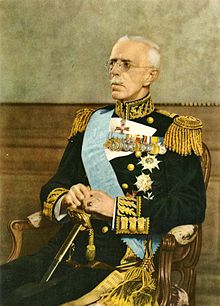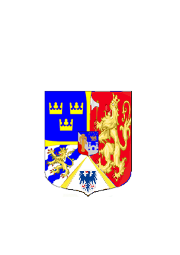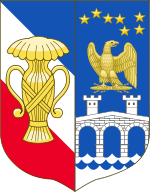- Gustaf V of Sweden
-
Gustaf V 
King of Sweden Reign 8 December 1907 - 29 October 1950 (42 years, 325 days) Predecessor Oscar II Successor Gustaf VI Adolf Spouse Victoria of Baden Issue Gustaf VI Adolf of Sweden
Prince Vilhelm, Duke of Södermanland
Prince Erik, Duke of VästmanlandFull name Oscar Gustaf Adolf Father Oscar II of Sweden Mother Sofia of Nassau Born 16 June 1858
Drottningholm PalaceDied 29 October 1950 (aged 92)
Drottningholm PalaceBurial Riddarholmen Church Religion Lutheran Gustaf V (Oscar Gustaf Adolf 16 June 1858 – 29 October 1950) was King of Sweden from 1907. He was the eldest son of King Oscar II of Sweden and Sophia of Nassau, a half-sister of Adolphe, Grand Duke of Luxembourg. Reigning until his death at age 92, he holds the record of being the oldest monarch of Sweden and the second-longest reigning (after Magnus IV).
Ascending to the throne in 1907, his early reign saw the rise of parliamentary rule in Sweden, although the leadup to World War I pre-empted his overthrow of Liberal Prime Minister Karl Staaff in 1914, replacing him with his own figurehead Hjalmar Hammarskjöld (father of Dag Hammarskjöld) for most of the war. In 1917 he accepted Staaff's successor Nils Edén to form a new government which de facto stripped the monarchy of its virtual powers and had enacted universal and equal suffrage, including for women, by 1919. Accepting the principles of parliamentary democracy, he remained a popular figurehead for the remainder 31 years of his rule, although not completely without influence - in the days of World War II he allegedly urged Per Albin Hansson's cabinet to accept calls from Nazi Germany to logistics support which, if refused, might have pre-empted an invasion, and remains controversial to date.
Contents
Early life
Gustaf V was born in Drottningholm Palace in Ekerö, Stockholm County and at birth was created Duke of Värmland and crown prince of both Sweden and Norway. On 8 December 1907, he succeeded his father on the Swedish throne, which had been separated from the Norwegian throne two years earlier.
On 20 September 1881 he married Princess Victoria of Baden in Karlsruhe, Germany. She was the granddaughter of Princess Sophie of Sweden, and her marriage to Gustaf V united, by a real blood link (and not only so-called adoption), the reigning Bernadotte dynasty with the former royal house of Holstein-Gottorp.
Public life
By inclination, Gustaf V was a conservative man, and did not approve of the democratic movement or demands for workers' rights. Theoretically, he was a near-autocrat under the 1809 Instrument of Government. However, his father had been forced to accept a government chosen by the majority in Parliament in 1905.
Gustaf V seemed to be willing to accept parliamentary rule. After the 1911 elections netted a massive landslide for the Liberals, Gustaf appointed Liberal leader Karl Staaff as Prime Minister, despite his own conservative predispositions. However, during the run-up to World War I, the elites objected to Staaff's defence policy. In February 1914, a large crowd of farmers gathered at the royal palace and demanded that the country's defences be strengthened. In his reply — the so-called court yard speech — Gustaf promised to strengthen the country's defences. Staaff was outraged, telling him that parliamentary rule called for the Crown to stay out of politics. However, Gustaf retorted that he had the right to speak to his own people. The Staaff government resigned in protest, and Gustaf appointed a civil servant government headed by Hjalmar Hammarskjöld (father Dag Hammarskjöld) in its place.
After the 1917 elections showed a heavy gain for the Liberals and Social Democrats, however, Gustaf was forced to appoint Staaff's successor, Nils Eden, as prime minister. By this time, it was apparent that Gustaf could not keep a government in office against the will of Parliament. He grudgingly accepted the principles of parliamentary rule, and reigned for the rest of his life as a model constitutional monarch.
Gustaf V was also the last Swedish King to be Supreme Commander of the Swedish Armed Forces (between 1907 and 1939).
Gustaf V was considered to have German sympathies during World War I. His political stance during the war was highly influenced by his wife, who felt a strong connection to her German homeland. On 18 December 1914, he sponsored a meeting with the other two Kings of Scandinavia to demonstrate unity within and between them. Another of Gustaf V's objectives with this three-King conference was to dispel suspicions that he wanted to bring Sweden into the war on Germany's side.
Nazi sympathies
Both the King and his grandson Prince Gustav Adolf socialized with certain Nazi leaders before World War II, though arguably for diplomatic purposes. Gustaf V attempted to convince Hitler during a visit to Berlin to soften his persecution of the Jews, according to historian Jörgen Weibull.[1] He was also noted for appealing to the leader of Hungary to save its Jews "in the name of humanity." [2] At the behest of American President Franklin D. Roosevelt, Gustaf V appealed to Hitler for peace negotiations in 1938, "in the interest of peace".[3]
When Nazi Germany invaded the Soviet Union in June 1941, Gustaf V tried to write a private letter to Hitler thanking him for taking care of the "Bolshevik pest" and congratulating him on his "already achieved victories".[4] He was stopped from doing so by the Prime Minister Hansson. Nevertheless, the King sent the message to Hitler (through a telegram by the German embassy in Stockholm) behind the back of the Government.
The 1941 Midsummer Crisis
According to Prime Minister Per Albin Hansson, the King in a private conversation had threatened to abdicate if the Government did not approve a German request to transfer a fighting infantry division – the so-called Engelbrecht Division – through Swedish territory from northern Norway to northern Finland in June 1941, around Midsummer. The accuracy of this claim is debated, and the King's intention (if he did in fact make this threat) is sometimes alleged to be his desire to avoid conflict with Germany. This event has later received considerable attention from Swedish historians and is known as midsommarkrisen, the Midsummer Crisis.[5]
Confirmation of the King's action is contained in German Foreign Policy documents captured at the end of the war. On 25 June 1941, the German Minister in Stockholm sent a "Most Urgent-Top Secret" message to Berlin in which he stated that the King had just informed him that the transit of German troops would be allowed. He added:
The King's words conveyed the joyful emotion he felt. He had lived through anxious days and had gone far in giving his personal support to the matter. He added confidentially that he had found it necessary to go so far as to mention his abdication. [6]
According to Ernst Wigforss, both Gustaf V and Prince Gustav Adolf attempted to persuade the Swedish Government to allow the Allies to transport troops through Sweden, though this was rejected by the Government because it was felt it would cause retributions from Germany.[7]
Personal life
Swedish Royalty
House of BernadotteCharles XIV John Children Oscar I Oscar I Children Charles XV Gustaf, Duke of Upland Oscar II Princess Eugenie August, Duke of Dalarna Charles XV Children Lovisa, Queen of Denmark Carl Oscar, Duke of Södermanland Oscar II Children Gustaf V Oscar, Duke of Gotland Eugén, Duke of Närke Carl, Duke of Västergötland Grandchildren Princess Margaretha Märtha, Crown Princess of Norway Astrid, Queen of Belgium Carl, Duke of Östergötland Gustaf V Children Gustaf VI Adolf Vilhelm, Duke of Södermanland Erik, Duke of Västmanland Gustaf VI Adolf Children Gustaf Adolf, Duke of Västerbotten Sigvard, Duke of Uppland Ingrid, Queen of Denmark Bertil, Duke of Halland Carl Johan, Duke of Dalarna Grandchildren Princess Margaretha Princess Birgitta Princess Désirée Princess Christina Carl XVI Gustaf Carl XVI Gustaf Children Crown Princess Victoria Carl Philip, Duke of Värmland Madeleine, Duchess of Hälsingland and Gästrikland Gustaf V was tall and thin. He wore pince-nez eyeglasses and sported a pointed mustache for most of his teen years.
Gustaf V was a devoted tennis player, appearing under the pseudonym Mr G. As a player and promoter of the sport, he was elected in to the International Tennis Hall of Fame in 1980. The King learned the sport during a visit in Britain in 1876 and founded Sweden's first tennis club on his return home. In 1936 he founded the King's Club. During his reign, Gustaf was often seen playing on the Riviera. On a visit to Berlin, Gustaf went straight from a meeting with Hitler to a tennis match with the Jewish player Daniel Prenn.[8] During World War II, he interceded to obtain better treatment for Davis Cup stars Jean Borotra of France and Gottfried von Cramm of Germany, who had been imprisoned by the German Government.
The Haijby affair
Allegations of a love affair between Gustav and Kurt Haijby, a wine wholesaler who sought to expand his business to the royal family, led to the court paying 170,000 kronor under threat of blackmail by Haijby. This led to the so-called Haijby affair and several criticized trials and convictions against Haijby which spawned considerably controversy about Gustav's alleged homosexuality.[9]
Styles titles, honours and arms
Gustaf V was the 1,062nd Knight of the Order of the Golden Fleece in Spain, the 828th Knight of the Order of the Garter in 1905 and the 216th Grand Cross of the Order of the Tower and Sword.
Styles titles, honours and arms
Upon his creation as Duke of Varmland, Gustaf V was granted a coat of amrs with the Arms of Varmland in base. Upon his accession to the throne, he assumed the Arms of Dominion of Sweden

Arms of Gustaf V as Duke of Varmland, until the dissolution of the Union between Sweden and Norway in 1905.

Arms of Gustaf V as King.
Death
After a reign of 43 years, King Gustaf V died in Stockholm, due to flu complications on 29 October 1950.
Image gallery
-
Portrait Crown Prince Gustav and Crown Princess Victoria in the early 1880s
-
Gustaf wears the Coronet of the Crown Prince and royal robes for a Riksdag opening in 1893
-
Gustaf V making his famous Courtyard Speech at Stockholm Palace in 1914
-
Speaking with Hjalmar Branting around 1920
-
Prince Gustav Adolf, Hermann Göring and Gustaf V in Berlin 1939.
Issue
Name Birth Death Notes King Gustaf VI Adolf of Sweden 11 November 1882 15 September 1973 married 1) Princess Margaret of Connaught (1882–1920), had issue (four sons, one daughter), married 2) Lady Louise Mountbatten (1889–1965), had issue (a stillborn daughter) Prince Vilhelm of Sweden, Duke of Södermanland 17 June 1884 5 June 1965 married Grand Duchess Maria Pavlovna of Russia (1890–1958), had issue Prince Erik of Sweden, Duke of Västmanland 20 April 1889 20 September 1918 died unmarried of the Spanish Flu, no issue Ancestors
Ancestors of Gustaf V of Sweden 16. Jean Henri Bernadotte 8. Charles XIV John of Sweden 17. Jeanne de Saint Vincent 4. Oscar I of Sweden 18. François Clary 9. Désirée Clary 19. Françoise Rose Somis 2. Oscar II of Sweden 20. Alexandre, vicomte de Beauharnais 10. Eugène de Beauharnais 21. Joséphine Tascher de la Pagerie 5. Josephine of Leuchtenberg 22. Maximilian I Joseph of Bavaria 11. Princess Augusta of Bavaria 23. Augusta Wilhelmine of Hesse-Darmstadt 1. Gustaf V of Sweden 24. Karl Christian of Nassau-Weilburg 12. Frederick William, Prince of Nassau-Weilburg 25. Princess Carolina of Orange-Nassau 6. William, Duke of Nassau 26. Wilhelm Georg, Burgrave of Kirchberg 13. Burgravine Louise Isabelle of Kirchberg 27. Princess Isabella Auguste of Reuss 3. Sofia of Nassau 28. Frederick I of Württemberg 14. Prince Paul of Württemberg 29. Augusta of Brunswick-Wolfenbüttel 7. Princess Pauline of Württemberg 30. Frederick, Duke of Saxe-Altenburg 15. Katharina Charlotte of Saxe-Hildburghausen 31. Duchess Charlotte Georgine of Mecklenburg-Strelitz References
- ^ Bernadottes on Sweden's Throne
- ^ sv:Gustaf V#note-14
- ^ sv:Gustaf V#note-16
- ^ Dagens Nyheter 070729 [1]
- ^ Hansson (Wahlbäck, Regeringen och kriget. Ur statsrådens dagböcker 1939-41) sv:Gustaf V#note-11
- ^ Documents of German Foreign Policy 1918-1945 Series D Volume XIII The War Years 23 June 1941 – 11 December 1941, Published in UK by HMSO and in US By Government Printing Office.
- ^ sv:Gustaf V#note-13
- ^ sv:Gustaf V#note-18
- ^ Heumann, Maths (1978) (in Swedish). Rättsaffärerna Kejne och Haijby. Stockholm: Norstedt. ISBN 91-1-787202-2.
- Opener of the 1912 Summer Olympics
External links
- Royal House of Sweden and Royal House of Norway
- Grand-Ducal House of Baden
- Gustaf V profile at the International Tennis Hall of Fame website
Gustaf VBorn: 16 June 1858 Died: 29 October 1950Regnal titles Preceded by
Oscar IIKing of Sweden
1907-1950Succeeded by
Gustaf VI AdolfSwedish royalty Preceded by
Oscar, Duke of ÖstergötlandHeir to the Swedish throne
1872-1907Succeeded by
Gustaf Adolf, Duke of Skåne
later became Gustaf VI AdolfVacant Title last held byCarl AdolfDuke of Värmland
1858-1907Vacant Title next held byCarl PhilipNorwegian royalty Preceded by
OscarHeir to the Norwegian throne
1872-1905Succeeded by
OlavVacant Title last held byCarlViceroy of Norway
1884Vacant Awards and achievements Preceded by
Sir Cyril NewallCover of Time Magazine
30 October 1939Succeeded by
Tom HarmonSwedish princes The generations indicate descent from Gustav I, of the House of Vasa, and continues through the Houses of Palatinate-Zweibrücken, Holstein-Gottorp; and the Bernadotte, the adoptive heirs of the House of Holstein-Gottorp, who were adoptive heirs of the Palatinate-Zweibrückens'.1st generation 2nd generation Sigismund I · Gustav, Prince of Uglich · Prince Henrik · Prince Arnold · Prince Ludwig · Prince Gustav · Prince John, Duke of Östergötland · Gustav II Adolf · Prince Charles Philip, Duke of Södermanland ·3rd generation Władysław IV Vasa, King of Poland and Grand Duke of Lithuania# · Prince Christopher# · Prince John Casimir# · John II Casimir Vasa, King of Poland and Grand Duke of Lithuania# · Prince Alexander Charles# · John Albert, Prince-Bishop of Warmia and Kraków# · Prince Charles Ferdinand, Duke of Opole#4th generation 5th generation Charles XII · Prince Gustav · Prince Ulrich · Prince Friedrich · Prince Charles Gustav · Frederick I~6th generation Adolf Frederick*7th generation 8th generation Gustav IV Adolf · Prince Carl Gustaf, Duke of Småland · Prince Carl Adolf, Duke of Värmland · Crown Prince Charles August* · Charles XIV John*,**9th generation 10th generation Prince Louis of Vasa · Charles XV** · Prince Gustaf, Duke of Uppland** · Oscar II** · Prince August, Duke of Dalarna11th generation 12th generation Gustaf VI Adolf** · Prince Vilhelm, Duke of Södermanland** · Prince Erik, Duke of Västmanland** · Prince Carl, Duke of Östergötland^13th generation 14th generation 15th generation *prince through adoption or election
**also prince of Norway
^lost his title due to an unequal marriage
#also prince of Poland and Lithuania
~also prince by marriageCategories:- People from Ekerö Municipality
- Dukes of Swedish Provinces
- House of Bernadotte
- Knights of the Order of Saint John (Bailiwick of Brandenburg)
- Knights of the Golden Fleece
- Knights of the Order of the Norwegian Lion
- Protestant monarchs
- Recipients of the Order of the Black Eagle
- Recipients of the Royal Victorian Chain
- Swedish Lutherans
- Swedish monarchs
- Swedish male tennis players
- International Tennis Hall of Fame inductees
- Uppsala University alumni
- World War II political leaders
- Recipients of the Order of the White Eagle (Poland)
- Swedish people of French descent
- Swedish monarchs of German descent
- Crown Princes of Sweden
- 1858 births
- 1950 deaths
- Burials at Riddarholmen Church
- Extra Knights Companion of the Garter
- Honorary Knights Grand Cross of the Royal Victorian Order
- Grand Crosses of the Order of the Tower and Sword
- Grand Commanders of the Order of the Dannebrog
- Recipients of the Silver Wolf Award
- Recipients of the Collar of the Order of the White Star
- Knights of the Order of the Most Holy Annunciation
-
Wikimedia Foundation. 2010.









